Table of Content
The patient presented to our office looking to replace his upper denture with permanent teeth. He has been wearing a full upper denture for about 7 years. However, there were several things that he did not like about his denture:
- He hated that his denture covered the roof of his mouth.
- It bothered him a lot that he had to take his teeth in and out daily.
Aside from these issues, the patient actually did relatively well with his dentures. He ate comfortably, spoke well, and liked the appearance of his false teeth. Still, he really wanted to replace his dentures with permanent, fixed teeth. We were happy to help him fix his smile with dental implants.
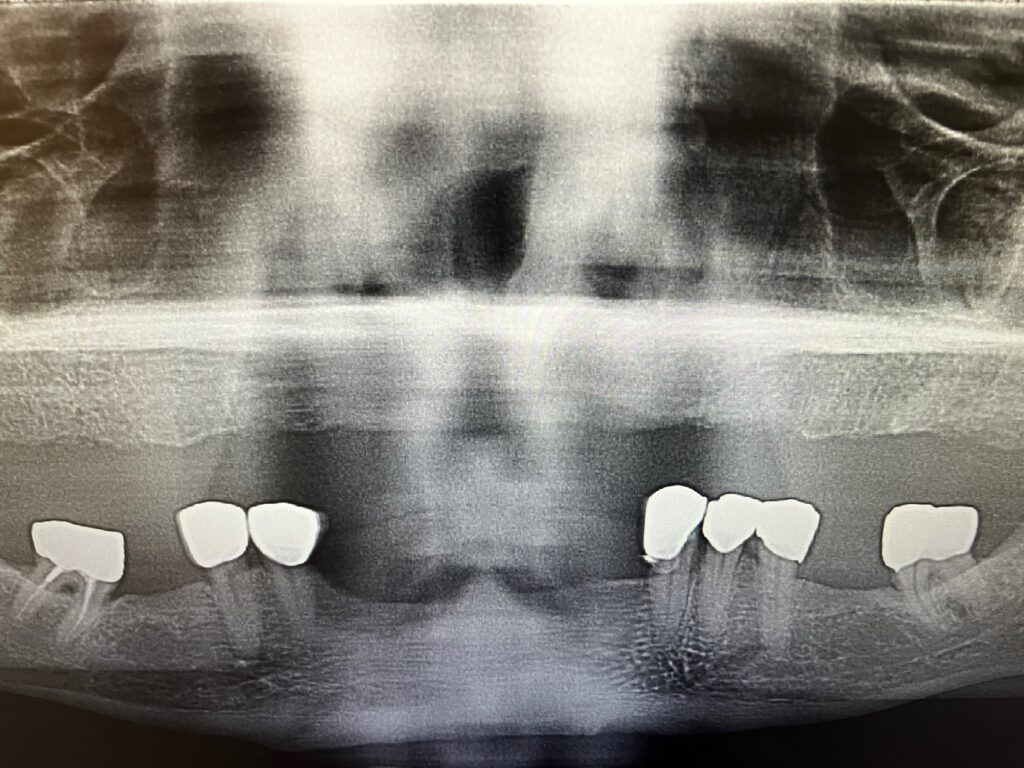
The patient had an excellent jawbone, in terms of quality and quantity. We decided to place 6 dental implants to support his permanent teeth. Note that this doesn't apply to everyone. These 5th and 6th implants are placed under the sinus cavities. Most patients do not have enough bone in these regions. In fact, most patients who seek this treatment barely have enough bone to support 4 implants. Since our patient had sufficient jawbone, we had the choice of placing 4 or more dental implants. Here are the benefits of placing 6 implants instead of 4:
- Sturdier prosthesis with more teeth
- Better long-term prognosis
- Option to fabricate a cement-retained prosthesis instead of screw-retained
- Better support, especially when opting for Zirconia teeth over porcelain-fused-to-metal
We explained the benefit of adding the two extra implants. Since the patient did not need additional bone grafting, the cost difference was nominal. The patient wisely decided to place 6 dental implants to support his Zirconia bridge.

The surgery was relatively straightforward. The patient elected to stay awake for the surgery. We successfully placed the six implants inside his upper jawbone. We took a CT scan to verify the position of the implants in 3-D. In order to line up the implants, we used the patient's existing denture to determine the final teeth' position. This makes it easier for the lab to fabricate the final bridge. Each implant was placed about 1 to 1.5 cm from the nearest implant. This provides for maximum stability and spreads out the bite forces evenly among the implants.
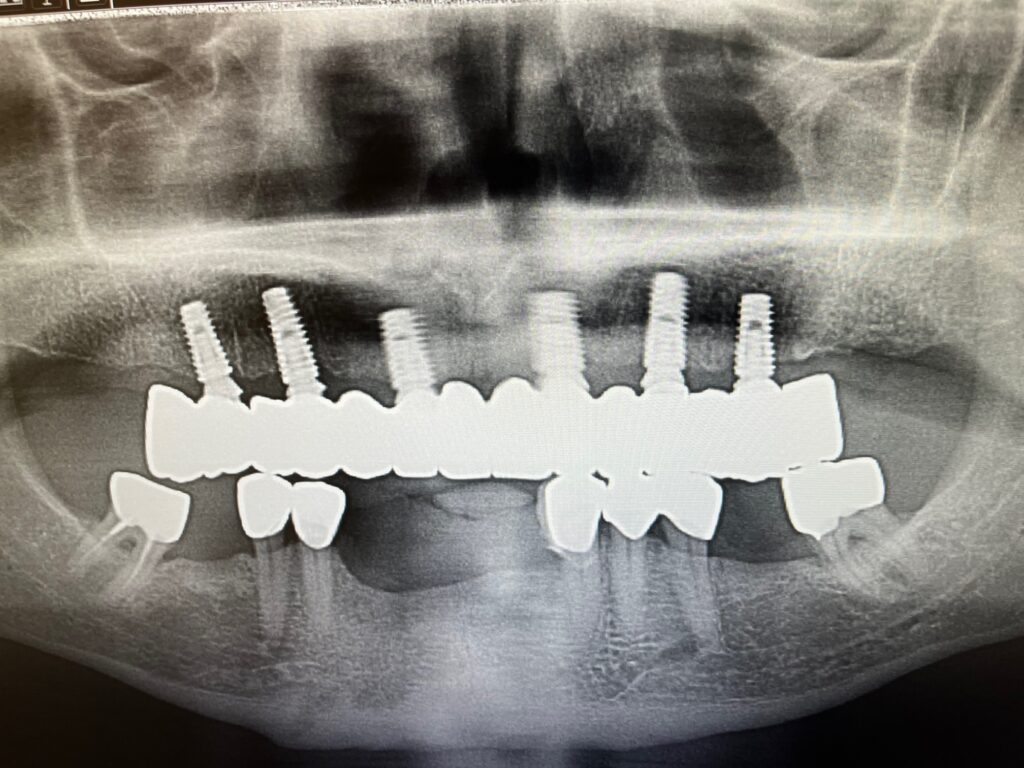
The patient received a 14-unit Zirconia bridge which was cemented in place. By placing the 5th and 6th implants, we were able to give the patient 2 additional teeth. This meant that the patient has 14 teeth on his permanent bridge, instead of the usual 12 teeth we typically place on all-on-4 implants. The reason for this is that you can extend the bridge only so much behind the most distal implant. Extending the bridge too far behind the most distal implant causes cantilever forces that fracture the bridge. If the patient were to receive only 4 implants instead of 6, he would have had approximately one less tooth on each side of the bridge.
We made a cement-retained bridge that was attached to the 6 abutments. In most cases, these bridges are screwed in. However, since we placed the additional 5th and 6th implant, both options were equally viable. Here's why we decide to go with a cement-retained prosthesis:
- Due to the angulation and position of the implants, a cement-retained restoration was the better option.
- We were able to cut down significantly on the number of visits required to fabricate the teeth
We went ahead with a Zirconia bridge over porcelain-fused-to-metal. Zirconia is significantly heavier than porcelain. Therefore, to place 14 teeth on a bridge, you almost always need an additional 5th or 6th implant. It's difficult placing a Zirconia bridge on only 4 implants due to the heavy weight of Zirconia. When working with just 4 dental implants, you need to have very, very long implants to support a Zirconia bridge. If the implants are smaller, a ceramic bridge will be too heavy. You almost always want to include the additional implants if you are planning on installing 14 teeth. With 4 implants, it's usually best to make a 12-unit bridge instead of 14. Here are some of the benefits of Zirconia bridge over porcelain-fused-to-metal:
- Ceramic has no metal underneath it the way that porcelain does so it looks more natural
- Zirconia is stronger than porcelain
- Zirconia does not strip from the metal substrate the way that porcelain-fused-to-metal bridges do
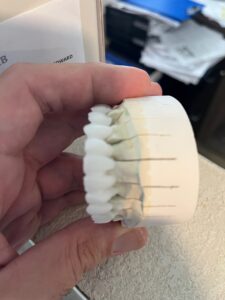
All-on-6 framework: we measure the teeth size and bake the final ceramic bridge on top of this framework.
Zirconia does have its disadvantages. The main disadvantage of Zirconia is that it can not be repaired. If a tooth were to chip or break, it can not be repaired. The good news is that Zirconia rarely ever breaks. Additionally, Zirconia is heavier than porcelain, which explains the need for the additional two implants in most instances. We make his bridge from a special type of Zirconia known as Bruxzir ceramic. Bruxzir is the toughest and strongest ceramic. This is by far the best option for full mouth bridge restorations, as it is the least likely to break with repeated use.
Thankfully, this patient's treatment went pretty quickly and took just 6 months from start to finish. Most all-on-4, all-on-6 treatments take significantly longer to complete. Therefore, you need to decide what type of temporary teeth to wear during treatment. There are a few options for temporary teeth, depending on the circumstances. These include:
- Fixed teeth (teeth in a day)
- Resin temporary bridge
- Current or new dentures, with holes to accommodate the dental implants
The patient already had a full upper denture that he was very happy with. As a result, we decided to use this denture as his temporary teeth. In order for this to work, we had to modify his denture two times:
The first adjustment was made to the denture after placing the implants. The implants were sticking above the jawbone since we added the healing caps right away. This can only be done if the patient has sufficient jawbone and there's no need for bone grafting. We took a putty impression with the denture in the patient's mouth. This helped us identify the location of the six implants. We used a slow-speed handpiece to create 6 small "dips" in the denture. The patient was then able to wear his dentures on top of the newly placed implants.
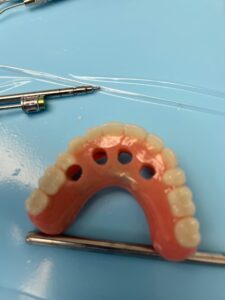
The next round of adjustments was after adding the abutments. Typically, we use removable abutments when restoring all-on-4 or all-on-6 teeth. In this case, we elected to lock in the abutments and prepare the bridge directly in the patient's mouth. While this helped facilitate fabricating the permanent teeth, it did pose a challenge when it comes to making temporary teeth. We ended up having to extend the six holes previously placed within the patient's dentures, converting them to through and through holes. The patient was then able to continue wearing his denture on top of the abutments while making his teeth.
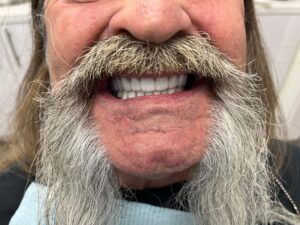
It took about 6 weeks to make the final Zirconia teeth. The final result was a 14-unit Zirconia bridge that sat on top of 6 dental implants. We used Bruxzir ceramic, which is the sturdiest and most durable Zirconia. The patient received his new smile and no longer needed to wear his dentures. He was beyond ecstatic! No more having the roof of his mouth covered. No more taking his teeth in and out. These permanent teeth are as close as you can get to having your own teeth back. Time to go eat some carrots, steak, and other similarly crunchy stuff!